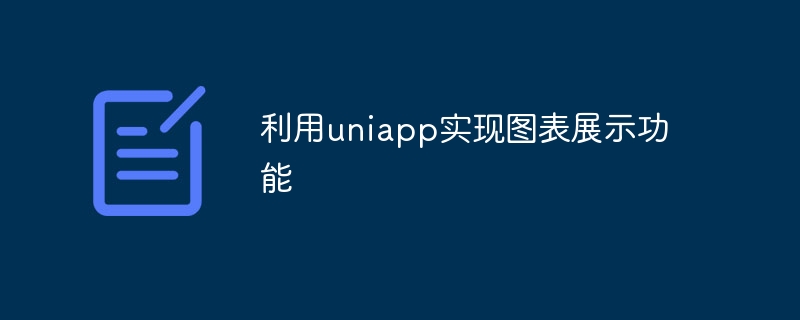Home >Web Front-end >uni-app >Use uniapp to implement chart display function
Use uniapp to implement chart display function
- WBOYWBOYWBOYWBOYWBOYWBOYWBOYWBOYWBOYWBOYWBOYWBOYWBOriginal
- 2023-11-21 08:57:451577browse

Use uniapp to realize chart display function
With the advent of the information age, data processing and visualization have become important tasks in various fields. In mobile terminal development, the chart display function has also become an indispensable component. Using the uniapp framework to implement the chart display function not only allows you to quickly develop efficient mobile applications, but is also compatible with multiple platforms and provides a consistent user experience.
1. Preparation
Before starting, we first need to prepare the development environment of uniapp and introduce the commonly used chart library echarts into the project. We can search for the echarts plug-in in the uniapp plug-in market and follow the prompts to install and introduce it.
2. Development steps
- Create a new uniapp project, enter the project root directory, open the index.vue file under the pages folder, and add a The canvas tag is used to display charts.
- Introduce the echarts library in the script tag and define a variable to save the chart instance:
import * as echarts from '@/plugins/ec-canvas/echarts.js';
export default {
data() {
return {
ec: {
lazyLoad: true
}
}
},
onLoad() {
this.$nextTick(() => {
this.initChart();
})
},
methods: {
initChart() {
this.ecComponent = this.$selectComponent('#mychart');
this.ecComponent.init((canvas, width, height) => {
const chart = echarts.init(canvas, null, {
width: width,
height: height
});
this.setOption(chart);
return chart;
})
},
setOption(chart) {
const option = {
// 在这里配置图表的样式和数据
};
chart.setOption(option);
}
}
}- Call the chart component in the page:
<template>
<view>
<canvas id="mychart" :style="canvasStyle"></canvas>
</view>
</template>- Configure the style and data of the chart in the setOption method. Taking the histogram as an example, we can define the horizontal and vertical axes and data series by configuring xAxis, yAxis and series. Specific configuration items can be adjusted according to needs:
setOption(chart) {
const option = {
xAxis: {
type: 'category',
data: ['Mon', 'Tue', 'Wed', 'Thu', 'Fri', 'Sat', 'Sun']
},
yAxis: {
type: 'value'
},
series: [{
data: [820, 932, 901, 934, 1290, 1330, 1320],
type: 'bar'
}]
};
chart.setOption(option);
}- Other types of charts can be used according to needs, such as line charts, pie charts, etc. Just modify the configuration items in the setOption method.
3. Running and debugging
After the code is written, we can use development tools such as HBuilderX to compile and run. Using the real machine debugging function of uniapp, you can view the chart effect in real time on your mobile phone.
Summary
Through the above steps, we can use the uniapp framework to quickly implement the chart display function. And because uniapp is compatible with multiple platforms, our applications can be developed once and released on multiple platforms. At the same time, the powerful functions of echarts can also meet various charting needs. I hope this article can help you implement the chart display function in uniapp development.
The above is the detailed content of Use uniapp to implement chart display function. For more information, please follow other related articles on the PHP Chinese website!
Related articles
See more- What are the five major functions that computer operating systems typically have?
- How to set page background color in uniapp
- How to set up synchronization and asynchronousness in uniapp
- How to use PHP to implement a simple data chart display function
- How to use PHP and Vue to implement chart display function

